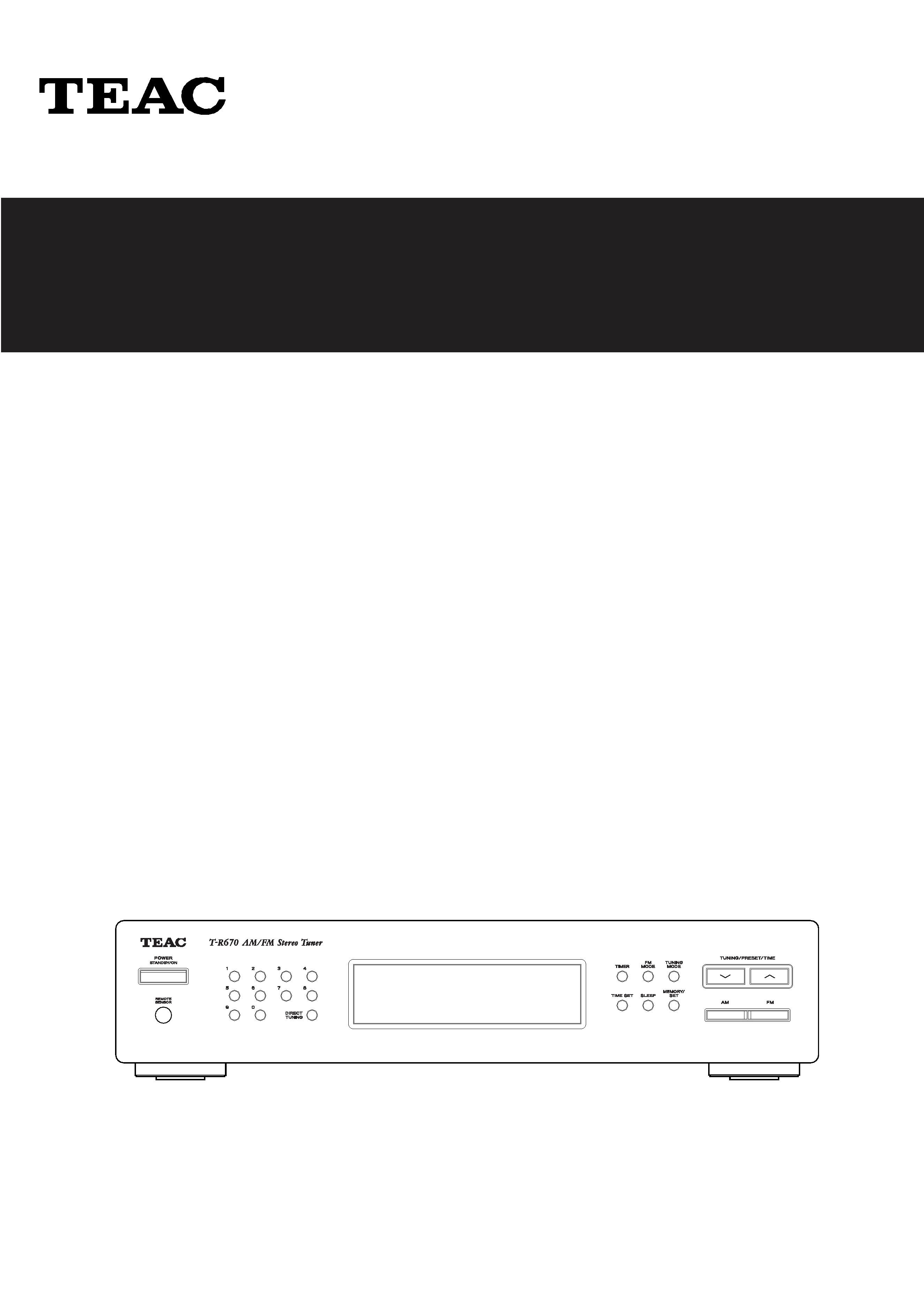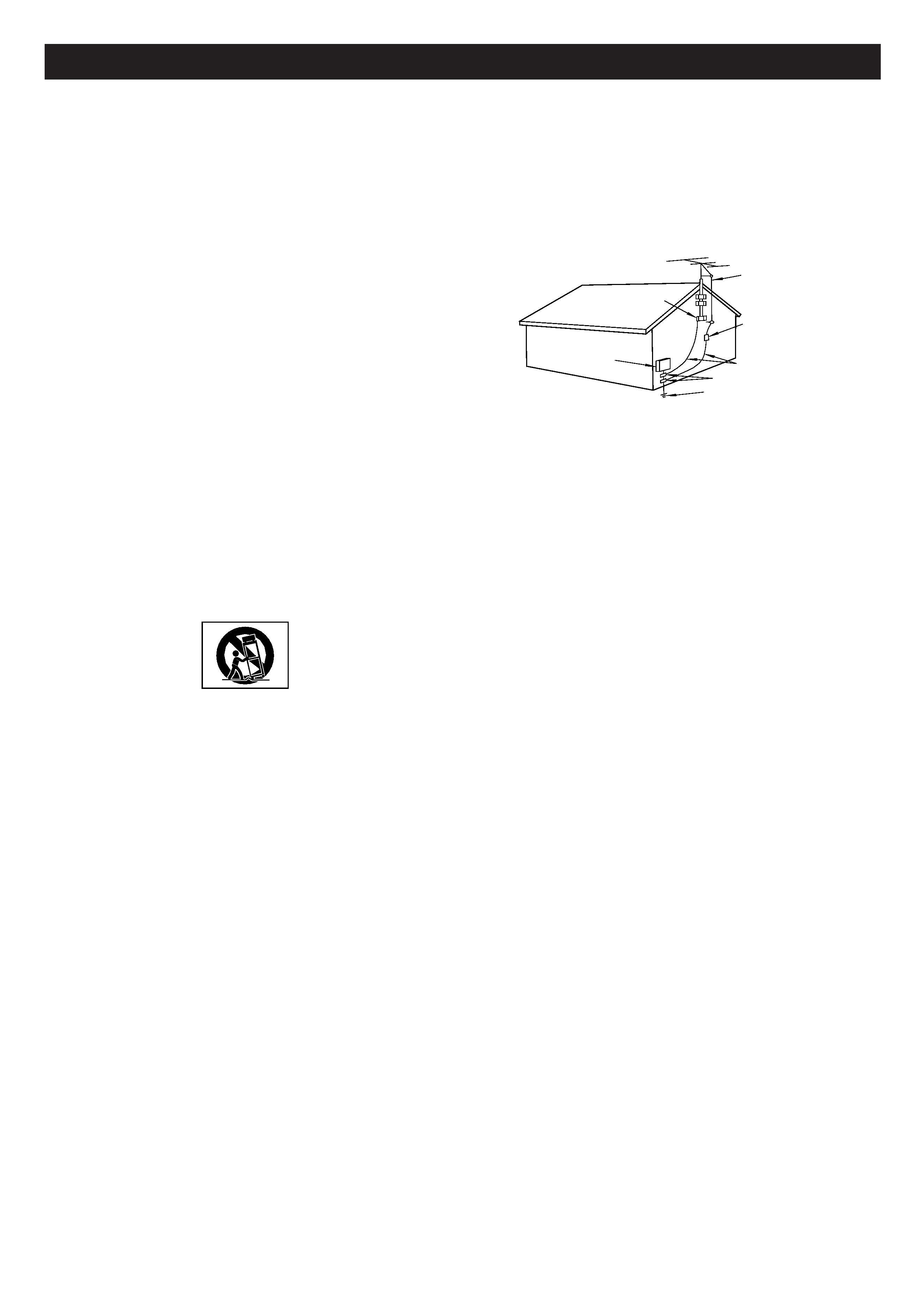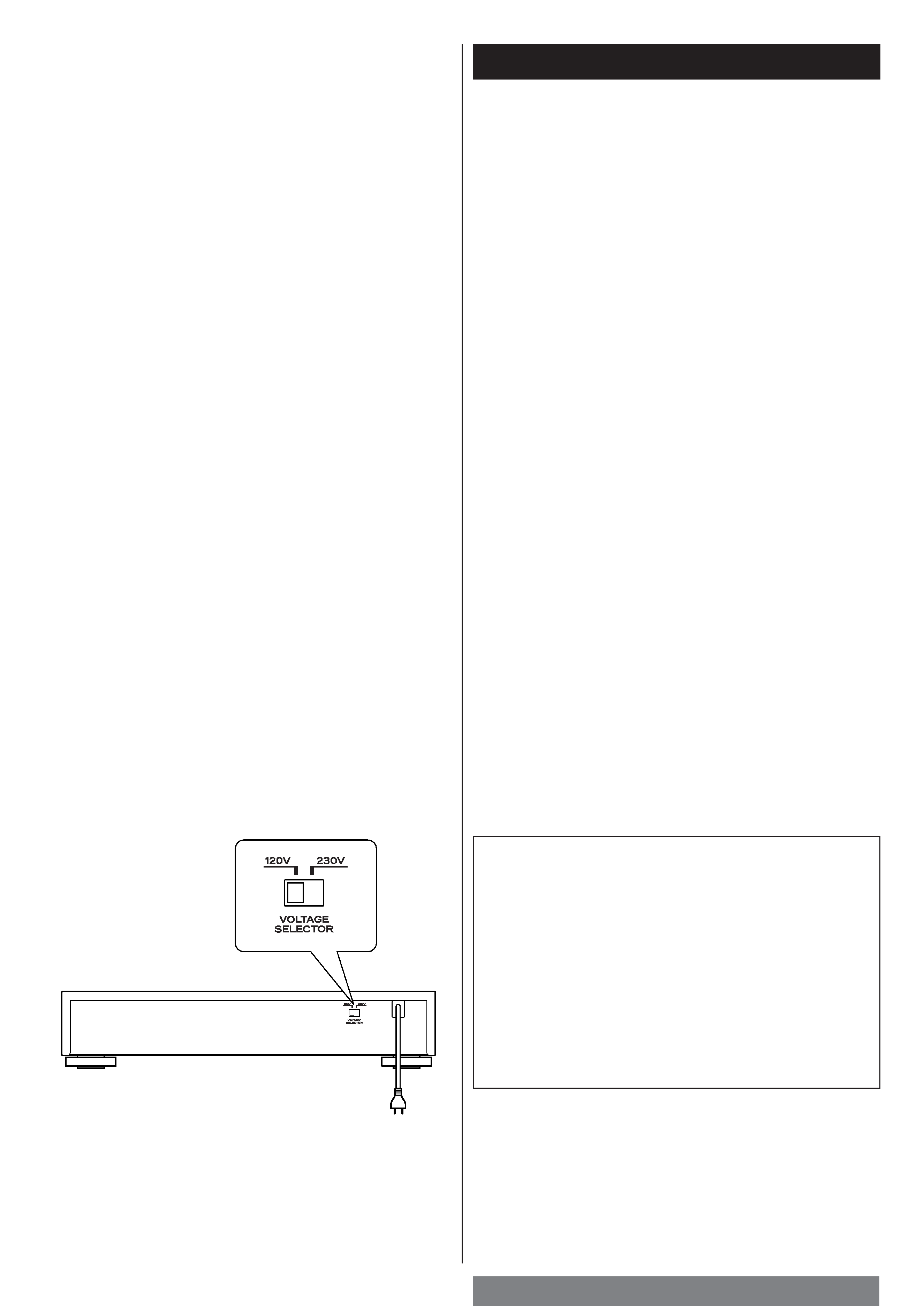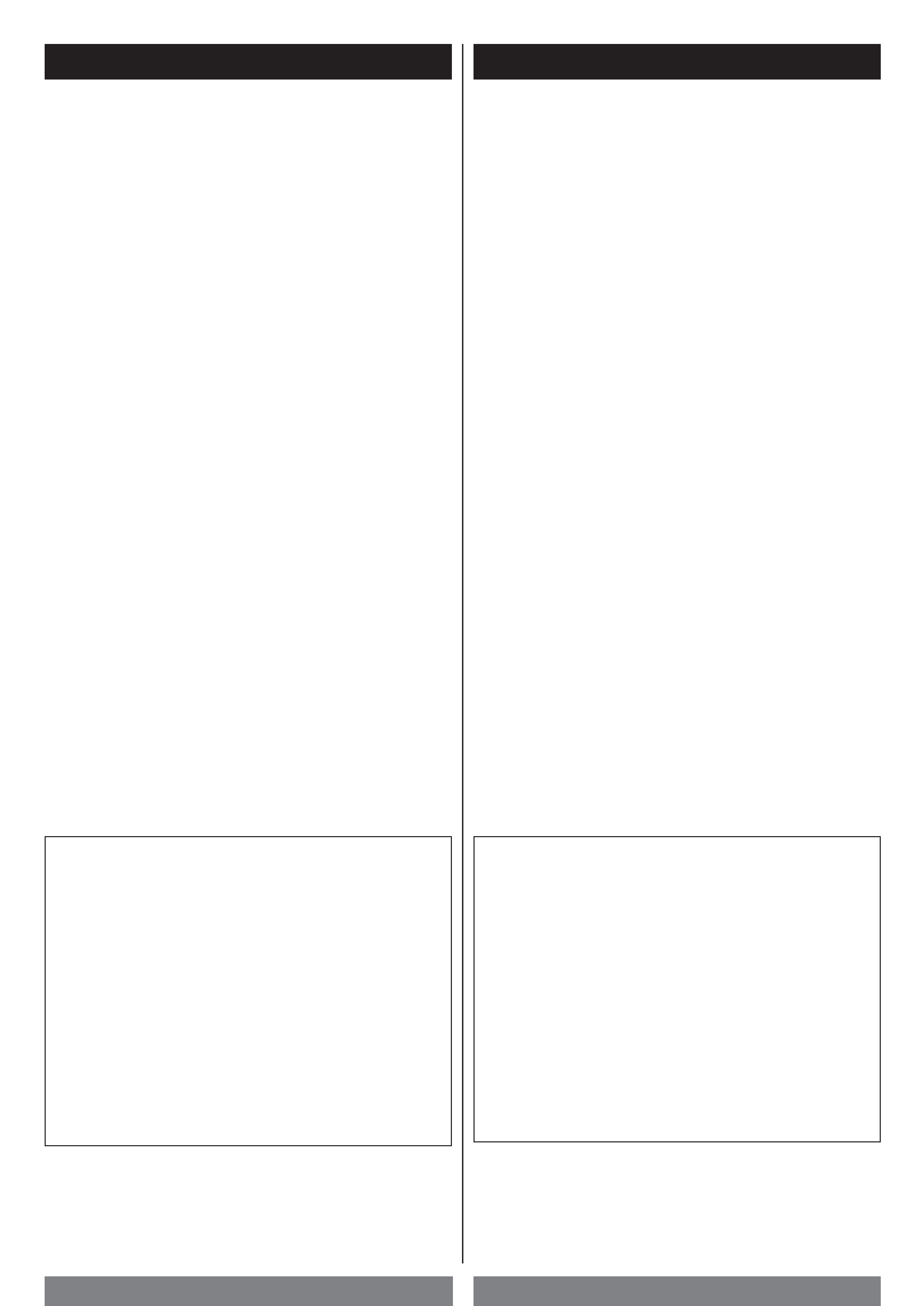
OWNER'S MANUAL
MANUEL DU PROPRIETAIRE
MANUAL DEL USUARIO
9A08814500
T-R670
AM / FM Stereo Tuner
Thanks for buying a TEAC. Read this manual carefully to get the best performance from this unit.
Nous vous remercions pour l'achat d'un appareil TEAC. Lire ce manuel avec attention pour obtenir les
meilleures performances possibles de cet appareil.
Enhorabuena por la adquisición de un TEAC. Lea detenidamente este manual a fin de obtener el mejor
rendimiento de esta unidad.

2
Important Safety Instructions
WARNING: TO PREVENT FIRE OR SHOCK HAZARD, DO NOT EXPOSE THIS APPLIANCE TO RAIN OR MOISTURE.
CAUTION: TO REDUCE THE RISK OF ELECTRIC SHOCK, DO NOT REMOVE COVER (OR BACK). NO USER-
SERVICEABLE PARTS INSIDE. REFER SERVICING TO QUALIFIED SERVICE PERSONNEL.
Y
E
R THE EXCLAMATION POINT WITHIN AN EQUILATERAL TRIANGLE IS INTENDED TO ALERT THE USER TO THE PRESENCE OF IMPORTANT
OPERATING AND MAINTENANCE (SERVICING) INSTRUCTIONS IN THE LITERATURE ACCOMPANYING THE APPLIANCE.
THE LIGHTNING FLASH WITH ARROWHEAD SYMBOL, WITHIN AN EQUILATERAL TRIANGLE, IS INTENDED TO ALERT THE USER TO THE
PRESENCE OF UNINSULATED "DANGEROUS VOLTAGE" WITHIN THE PRODUCT'S ENCLOSURE THAT MAY BE OF SUFFICIENT MAGNITUDE TO
CONSTITUTE A RISK OF ELECTRIC SHOCK TO PERSONS.
AC POWER CORD CONNECTION
CAUTION:
TO PREVENT ELECTRIC SHOCK, MATCH WIDE BLADE OF PLUG
TO WIDE SLOT, FULLY INSERT.
CORDE DE CONNEXION CA
ATTENTION:
POUR ÉVITER LES CHOCS ÉLECTRIQUES, INTRODUIRE LA
LAME LA PLUS LARGE DE LA FICHE DANS LA BORNE
CORRESPONDANTE DE LA PRISE ET POUSSER JUSQU'AU
FOND.
For CANADA
Pour le CANADA
TO THE USER
This equipment has been tested and found to comply with the limits for a Class B digital device, pursuant to Part 15 of the FCC
Rules. These limits are designed to provide reasonable protection against interference in a residential area. This device
generates and uses radio frequency energy and if not installed and used in accordance with the instructions, it may cause
interference to radio or TV reception. If this unit does cause interference with TV or radio reception you can try to correct the
interference by one or more of the following measures :
a) Reorient or relocate the receiving antenna.
b) Increase the separation between the equipment and the receiver.
c) Plug the equipment into a different outlet so that it is not on the same circuit as the receiver. If necessary, consult the dealer
or an experienced radio/TV technician for additional suggestions.
CAUTION
Changes or modifications to this equipment not expressly approved by TEAC CORPORATION for compliance could void the user's
authority to operate this equipment.
For U.S.A.

Important Safety Instructions
3
CAUTION
< Read all of these Instructions.
< Save these Instructions for later use.
< Follow all Warnings and Instructions marked on the audio equipment.
1) Read Instructions -- All the safety and operating instructions should
be read before the product is operated.
2) Retain Instructions -- The safety and operating instructions should
be retained for future reference.
3) Heed Warnings -- All warnings on the product and in the operating
instructions should be adhered to.
4) Follow Instructions -- All operating and use instructions should be
followed.
5) Cleaning -- Unplug this product from the wall outlet before cleaning.
Do not use liquid cleaners or aerosol cleaners. Use a damp cloth for
cleaning.
6) Attachments -- Do not use attachments not recommended by the
product manufacturer as they may cause hazards.
7) Water and Moisture -- Do not use this product near water -- for
example, near a bath tub, wash bowl, kitchen sink, or laundry tub; in a
wet basement; or near a swimming pool; and the like.
8) Accessories -- Do not place this product on an unstable cart, stand,
tripod, bracket, or table. The product may fall, causing serious injury to
a child or adult, and serious damage to the product. Use only with a
cart, stand, tripod, bracket, or table recommended by the manufacturer,
or sold with the product. Any mounting of the product should follow the
manufacturer's instructions, and should use a mounting accessory
recommended by the manufacturer.
9) A product and cart combination should be moved with care. Quick
stops, excessive force, and uneven surfaces may cause the product
and cart combination to overturn.
10) Ventilation -- Slots and openings in the cabinet are provided for
ventilation and to ensure reliable operation of the product and to
protect it from overheating, and these openings must not be blocked or
covered. The openings should never be blocked by placing the product
on a bed, sofa, rug, or other similar surface. This product should not be
placed in a built-in installation such as a bookcase or rack unless
proper ventilation is provided or the manufacturer's instructions have
been adhered to.
11) Power Sources -- This product should be operated only from the
type of power source indicated on the marking label. If you are not sure
of the type of power supply to your home, consult your product dealer
or local power company. For products intended to operate from battery
power, or other sources, refer to the operating instructions.
12) Grounding or Polarization -- This product may be equipped with a
polarized alternating-current line plug (a plug having one blade wider
than the other). This plug will fit into the power outlet only one way. This
is a safety feature. If you are unable to insert the plug fully into the
outlet, try reversing the plug. If the plug should still fail to fit, contact
your electrician to replace your obsolete outlet. Do not defeat the safety
purpose of the polarized plug.
13) Power-Cord Protection -- Power-supply cords should be routed so
that they are not likely to be walked on or pinched by items placed upon
or against them, paying particular attention to cords at plugs,
convenience receptacles, and the point where they exit from the
product.
14) Outdoor Antenna Grounding -- If an outside antenna or
cable
system is connected to the product, be sure the antenna or cable
system is grounded so as to provide some protection against voltage
surges and built-up static charges. Article 810 of the National Electrical
Code, ANSI/NFPA 70, provides information with regard to proper
grounding of the mast and supporting structure, grounding of the lead-
in wire to an antenna discharge unit, size of grounding conductors,
location of antenna-discharge unit, connection to grounding electrodes,
and requirements for the grounding electrode.
Note to CATV system installer:
This reminder is provided to call the CATV system installer's attention to
Section 820-40 of the NEC which provides guidelines for proper
grounding and, in particular, specifies that the cable ground shall be
connected to the grounding system of the building, as close to the point
of cable entry as practical."
15) Lightning -- For added protection for this product during a lightning
storm, or when it is left unattended and unused for long periods of time,
unplug it from the wall outlet and disconnect the antenna or cable
system. This will prevent damage to the product due to lightning and
power-line surges.
16) Power Lines -- An outside antenna system should not be located in
the vicinity of overhead power lines or other electric light or power
circuits, or where it can fall into such power lines or circuits. When
installing an outside antenna system, extreme care should be taken to
keep from touching such power lines or circuits as contact with them
might be fatal.
17) Overloading -- Do not overload wall outlets, extension cords, or
integral convenience receptacles as this can result in risk of fire or
electric shock.
18) Object and Liquid Entry -- Never push objects of any kind into this
product through openings as they may touch dangerous voltage points
or short-out parts that could result in a fire or electric shock. Never spill
liquid of any kind on the product.
19) Servicing -- Do not attempt to service this product yourself as
opening or removing covers may expose you to dangerous voltage or
other hazards. Refer all servicing to qualified service personnel.
20) Damage Requiring Service -- Unplug this product from the wall
outlet and refer servicing to qualified service personnel under the
following conditions:
a ) when the power-supply cord or plug is damaged.
b ) if liquid has been spilled, or objects have fallen into the product.
c ) if the product has been exposed to rain or water.
d) if the product does not operate normally by following the operating
instructions. Adjust only those controls that are covered by the
operating instructions as an improper adjustment of other controls may
result in damage and will often require extensive work by a qualified
technician to restore the product to its normal operation.
e) if the product has been dropped or damaged in any way.
f) when the product exhibits a distinct change in performance _ this
indicates a need for service.
21) Replacement Parts -- When replacement parts are required, be
sure the service technician has used replacement parts specified by
the manufacturer or have the same characteristics as the original part.
Unauthorized substitutions may result in fire, electric shock, or other
hazards.
22) Safety Check -- Upon completion of any service or repairs to this
product, ask the service technician to perform safety checks to
determine that the product is in proper operating condition.
23) Wall or Ceiling Mounting -- The product should be mounted to a
wall or ceiling only as recommended by the manufacturer.
24) Heat -- The product should be situated away from heat sources
such as radiators, heat registers, stoves, or other products (including
amplifiers) that produce heat.
ANTENNA
LEAD IN
WIRE
ANTENNA
DISCHARGE UNIT
(NEC SECTION 810-20)
GROUNDING CONDUCTORS
(NEC SECTION 810-21)
GROUND CLAMPS
POWER SERVICE GROUNDING
ELECTRODE SYSTEM
(NEC ART 250. PART H)
NEC - NATIONAL ELECTRICAL CODE
ELECTRIC
SERVICE
EQUIPMENT
Example of Antenna Grounding
as per National Electrical
Code, ANSI/NFPA 70
GROUND
CLAMP

Contents
4
ENGLISH
Before Use..............................................................................................6
Connecting Antennas ..........................................................................8
Connection with an Amplifire ............................................................10
Remote Control Unit ...........................................................................12
Name of Each Control ........................................................................14
Radio Reception .................................................................................16
Direct Tuning ...................................................................................18
Preset Tuning ..................................................................................20
Manual Memory Presetting ..........................................................22
Setting the Clock ................................................................................24
Sleep Timer .........................................................................................24
Setting the Timer ................................................................................26
Troubleshooting ..................................................................................28
Specifications .....................................................................................28
Voltage Conversion
(General export models only)
Be sure to remove the power cord from the AC outlet before
repositioning the voltage converter switch.
1. Locate the voltage selector on the rear panel.
2. Using a flat-bladed screwdriver, set to the appropriate
230V or 120V position according to your area.
IN NORTH AMERICA USE ONLY ON 120 V SUPPLY.

Changement de tension
(Modèles d'exportation générale seulement)
Bien débrancher le cordon d'alimentation de la prise
secteur avant de repositionner le sélecteur de changement
de tension.
1. Localiser le sélecteur de tension à l'arrière de l'appareil.
2. En utilisant un tournevis à lame plate, régler sur la
position appropriée 230V ou 120V en fonction de la
tension locale.
DANS L'AMÉRIQUE DU NORD: UTILISABLE SUR 120 V
D'ALIMENTATION UNIQUEMENT.
Sommaire
Indice
5
FRANÇAIS
ESPAÑOL
Avant Utilisation ...................................................................................7
Raccordements d'antenne .................................................................9
Raccordement à un amplificateur ...................................................11
Télécommande ...................................................................................13
Nomenclature .....................................................................................15
Réception de la radio .........................................................................17
Syntonisation directe .....................................................................19
Syntonisation préréglée ................................................................21
Préréglage manuel de la mémoire ..............................................23
Réglage de l'horloge ..........................................................................25
Temporisation de veille .....................................................................25
Réglage de la temporisation (Timer) ...............................................27
Dépannage ..........................................................................................29
Spécifications .....................................................................................29
Previo al empleo ...................................................................................7
Conexión de antenas ...........................................................................9
Conexión con un amplificador .........................................................11
Control remoto .....................................................................................13
Nombre de los controles....................................................................15
Recepción de radio .............................................................................17
Sintonización directa ......................................................................19
Sintonización preajustada .............................................................21
Preajuste manual de memoria ......................................................23
Ajuste del reloj .....................................................................................25
Temporizador para dormir .................................................................25
Ajuste del temporizador .....................................................................27
Solución de problemas.......................................................................30
Especificaciones .................................................................................30
Conversión de voltaje
(Únicamente modelos generales par a exportación)
Asegúrese de quitar el cable de energía de la salida de CA
antes de volver de colocar el interruptor convertidor de
voltaje.
1. Localice el selector de voltaje en el tablero posterior.
2. Utilizando un destornillador de hoja plana, ajuste a la
posición adecuada de 230V o 220V de acuerdo con su
área.
EN NORTEAMÉRICA, UTILICE ÚNICAMENTE SUMINSITRO
DE 120 V
